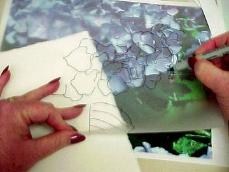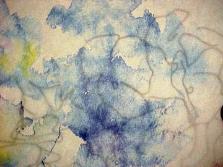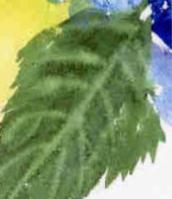Painting Hydrangeas in Watercolor ~
Using watermarks to create the blooms!
Using watermarks to create the blooms!
Pictured is the beginning of
a demonstration of painting
cluster blossoms of floweres
such as the hydrangea.
1. Starting with wet juicy
paint on dry paper I painted
the illusion of the cluster by
painting the four petals of a
flower shape sided by side in
a group or cluster. Many of
these shapes intermingled
and overlaped. the shape
next to it.
2. While it is still semi-wet to
damp, splater or spritz or
splash clear water into the
painted petals. This creates
the most wonderful water
marks or "blooms". Now let
it dry and let the watercolor
do its thing.
a demonstration of painting
cluster blossoms of floweres
such as the hydrangea.
1. Starting with wet juicy
paint on dry paper I painted
the illusion of the cluster by
painting the four petals of a
flower shape sided by side in
a group or cluster. Many of
these shapes intermingled
and overlaped. the shape
next to it.
2. While it is still semi-wet to
damp, splater or spritz or
splash clear water into the
painted petals. This creates
the most wonderful water
marks or "blooms". Now let
it dry and let the watercolor
do its thing.
Watermarks or
"blooms" are formed
by dropping clear water
into the blue painted
petal shapes.
"blooms" are formed
by dropping clear water
into the blue painted
petal shapes.
When the paper is dry, pencil in the shapes using the blooms
created by the water drops. Then paint around them and blend
off. Some of the four petal shapes will be positive and some will
be negative. See more details for this step in the examples
below.
created by the water drops. Then paint around them and blend
off. Some of the four petal shapes will be positive and some will
be negative. See more details for this step in the examples
below.
3.) To add a softer less defined vein is to
"draw" or paint the veins in using clear water
in a damp/moist brush after the painted leaf
has had a little time for the paint to settle
and set up. It will be at a stage where it is
starting to loose its shine but is not dry.
"draw" or paint the veins in using clear water
in a damp/moist brush after the painted leaf
has had a little time for the paint to settle
and set up. It will be at a stage where it is
starting to loose its shine but is not dry.
4.) When you paint the leaves you can add
veins as you go. The darker veins are scored
or scratched into the wet paint.
For the lighter veins wait until the paint has
settled and dried some but is still damp and
then scrape away some of the pigment
leaving the illusion of lighter veins.
veins as you go. The darker veins are scored
or scratched into the wet paint.
For the lighter veins wait until the paint has
settled and dried some but is still damp and
then scrape away some of the pigment
leaving the illusion of lighter veins.
| Click on the images below for larger photo references ~ Courtesy of Susie! |



To make a pattern or line
drawing to work from, place a
piece of tracing paper or
transparency film over your
photo and trace the simple
lines or shapes.
drawing to work from, place a
piece of tracing paper or
transparency film over your
photo and trace the simple
lines or shapes.
This pattern can be moved
and adjusted to match your
painting and help you in
finding the petal shapes.
Lightly outine these shapes
with a No. 2 pencil.
(HINT: If you use watercolor
pencils for this step you won't
have any pencil lines to erase!)
and adjusted to match your
painting and help you in
finding the petal shapes.
Lightly outine these shapes
with a No. 2 pencil.
(HINT: If you use watercolor
pencils for this step you won't
have any pencil lines to erase!)
After the splattered blue paint
on the watercolor paper has
dried, the pattern is place
under the painting so the
shapes can be transfered
using a lightbox or window. As
you can see the pattern is
visable through 140 lb. CP
paper.
on the watercolor paper has
dried, the pattern is place
under the painting so the
shapes can be transfered
using a lightbox or window. As
you can see the pattern is
visable through 140 lb. CP
paper.
| FINISHING YOUR PAINTING: Adding definition and details by using both the positive and negative shapes will bring your hydrangea painting to life. This final step in the process is simple but time consuming because you are repeating it over the entire hydrangea bloom. Your painting can be as loose and splashy or as detailed as you want to make it. The hydrangea painting on the right is by one of my very talented online students. (Deb Leger, Canada) |




1
2
3

4

| Permission to print single copy for personal use only. (C) Copyright 2003 Susie Short Studio LLC ~ ~ www.susieshort.com ~ ~ email: susie@susieshort.com |



